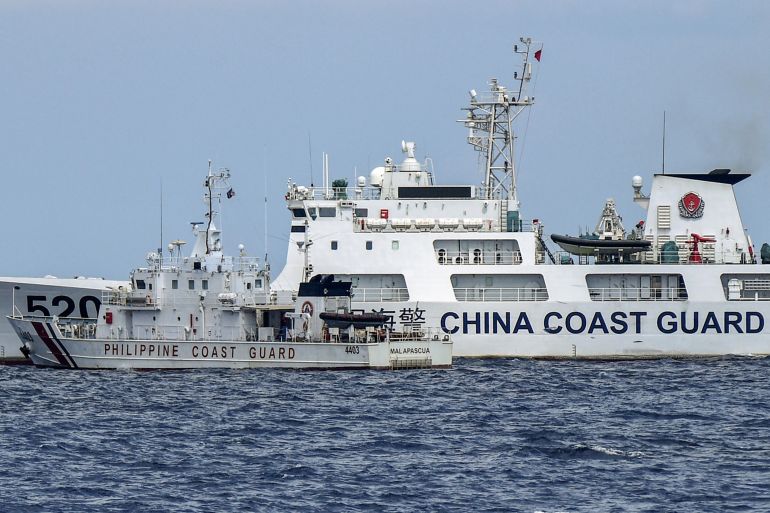Philippines reports ‘confrontation’ with China in South China Sea
Philippines Coast Guard accuses China of engaging in ‘dangerous maneuvers’ around Second Thomas Shoal.

The Philippine Coast Guard (PCG) has said two of its vessels were involved in a “confrontation” with the Chinese navy in the disputed South China Sea and accused the Chinese Coast Guard (CCG) of engaging in “dangerous maneuvers” at Second Thomas Shoal, a long-running flashpoint between the two countries.
The first incident occurred when the Chinese navy ship “crossed paths” with the coastguard boats 7 nautical miles (13km) from Pag-asa Island on April 21, the PCG said in a statement on Friday. The rock in the disputed Spratly Islands, also known as Thitu Island, was occupied by the Philippines in the 1970s and is now home to as many as 400 people.
Keep reading
list of 4 itemsChinese military says US ship ‘warned’ away in South China Sea
US gets new Philippine bases with South China Sea, Taiwan in mind
China and Cambodia hold first naval drills in Cambodian waters
The coastguard said the confrontation began when the Chinese corvette ordered the PCG vessels to leave, and suggested that failure to comply might “cause [a] problem”.
The statement said the PCG vessels “did not back down and responded by asserting their rights to carry out operations within the territorial sea of Pag-asa Island”. and asked the Chinese navy to leave.
The second incident took place two days later near Second Thomas Shoal, known as Ayungin Shoal in the Philippines.
On this occasion, the PCG ships were intercepted by two CCG ships that “exhibited aggressive tactics”, the PCG statement said.
One of the Chinese ships “was reported to have carried out dangerous maneuvers … maintaining a perilous distance of only 50 yards (46 metres),” it said.
“This close proximity posed a significant threat to the safety and security of the Philippine vessel and its crew,” the statement said, noting that the second Chinese ship closely monitored the movements of the other PCG ship at a distance of about 640 metres (700 yards).
Here is the footage of the CCG vessel’s unsafe and unprofessional maneuver to block the PCG vessel from replenishing the BRP Sierra Madre. China is a signatory to COLREGs, which is meant to prevent such unsafe practices. https://t.co/VeLXgmjPVV video courtesy of @AP. pic.twitter.com/Rj2DssHBQ0
— Lyle Morris (@LyleJMorris) April 27, 2023
The second incident took place at the same time as the PCG was taking a number of journalists on a tour of the area.
China claims almost the entire South China Sea and has ignored an international court ruling brought by the Philippines that there was no historical basis for its claim.
The ruling also found that China’s actions had breached several articles under the United Nations Convention on the Law of the Sea (UNCLOS) on safety and navigation at sea following incidents at Scarborough Shoal in 2012, according to Lyle Morris, a senior fellow for foreign policy and national security at the Asia Society Policy Institute’s Center for China Analysis.
Despite the 2016 decision, Beijing has continued to expand and develop military outposts and deploy fishing fleets, its maritime militia and the coastguard to assert its claim to the South China Sea.
The PCG statement said its ships had also encountered more than 100 alleged Chinese maritime militia vessels during their weeklong patrol of shoals and features around the West Philippine Sea, which ended on April 24.
As well as China and the Philippines, states including Vietnam, Malaysia and Brunei, as well as self-ruled Taiwan have claims on the South China Sea.
The Philippines in February accused China of using a powerful laser against one of its ships on a resupply mission at Second Thomas Shoal and lodged a protest.
The shoal lies about 195km (121 miles) northwest of the Philippine province of Palawan in the disputed Spratly Islands, and is home to a small group of Philippine soldiers who are living on board a rusting second world war-era ship known as the Sierra Madre, which was deliberately grounded there in 1999 to underline the Philippines’ claim to the island chain.
CCG patrols were also involved in a serious confrontation with Vietnamese vessels near key Vietnamese gas and oil fields last month, while tensions have been building too near Malaysia’s Kasawari gas development project, according to the Asia Maritime Transparency Initiative.